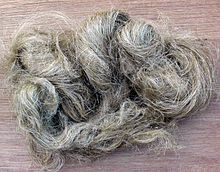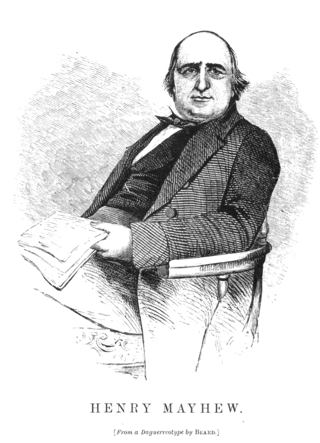
Henry Mayhew was an English journalist, playwright, and advocate of reform. He was one of the co-founders of the satirical magazine Punch in 1841, and was the magazine's joint editor, with Mark Lemon, in its early days. He is also known for his work as a social researcher, publishing an extensive series of newspaper articles in the Morning Chronicle that was later compiled into the three-volume book London Labour and the London Poor (1851), a groundbreaking and influential survey of the city's poor.
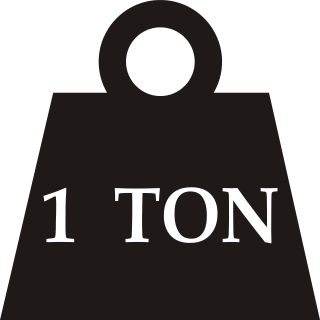
Ton is any of several units of measure of mass, volume or force. It has a long history and has acquired several meanings and uses.

Pitch is a viscoelastic polymer which can be natural or manufactured, derived from petroleum, coal tar, or plants. Pitch produced from petroleum may be called bitumen or asphalt, while plant-derived pitch, a resin, is known as rosin in its solid form. Tar is sometimes used interchangeably with pitch, but generally refers to a more liquid substance derived from coal production, including coal tar, or from plants, as in pine tar.
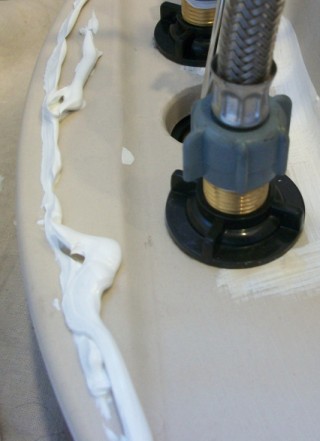
Caulk or caulking is a material used to seal joints or seams against leakage in various structures and piping.

Plastic welding is welding for semi-finished plastic materials, and is described in ISO 472 as a process of uniting softened surfaces of materials, generally with the aid of heat. Welding of thermoplastics is accomplished in three sequential stages, namely surface preparation, application of heat and pressure, and cooling. Numerous welding methods have been developed for the joining of semi-finished plastic materials. Based on the mechanism of heat generation at the welding interface, welding methods for thermoplastics can be classified as external and internal heating methods, as shown in Fig 1.

Turret ships were a 19th-century type of warship, the earliest to have their guns mounted in a revolving gun turret, instead of a broadside arrangement.

The Parrott rifle was a type of muzzle-loading rifled artillery weapon used extensively in the American Civil War.

Strapping, also known as bundling and banding, is the process of applying a strap to an item to combine, stabilize, hold, reinforce, or fasten it. A strap may also be referred to as strapping. Strapping is most commonly used in the packaging industry.

Penal labour is a term for various kinds of forced labour that prisoners are required to perform, typically manual labour. The work may be light or hard, depending on the context. Forms of sentence involving penal labour have included involuntary servitude, penal servitude, and imprisonment with hard labour. The term may refer to several related scenarios: labour as a form of punishment, the prison system used as a means to secure labour, and labour as providing occupation for convicts. These scenarios can be applied to those imprisoned for political, religious, war, or other reasons as well as to criminal convicts.
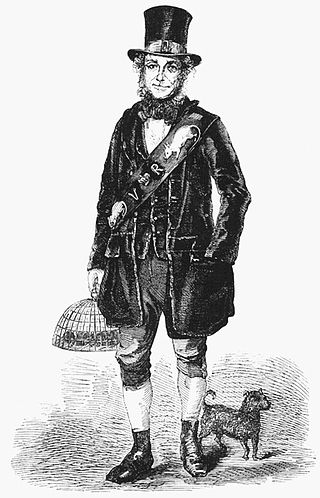
London Labour and the London Poor is a work of Victorian journalism by Henry Mayhew. In the 1840s, he observed, documented and described the state of working people in London for a series of articles in a newspaper, the Morning Chronicle, which were later compiled into book form.

Designated as an American National Standard, the Uniform Plumbing Code (UPC) is a model code developed by the International Association of Plumbing and Mechanical Officials (IAPMO) to govern the installation and inspection of plumbing systems as a means of promoting the public's health, safety and welfare.

A pipe is a tubular section or hollow cylinder, usually but not necessarily of circular cross-section, used mainly to convey substances which can flow — liquids and gases (fluids), slurries, powders and masses of small solids. It can also be used for structural applications; hollow pipe is far stiffer per unit weight than solid members.

The Armstrong RBL 7-inch gun, also known as the 110-pounder, was a heavy caliber Armstrong gun, an early type of rifled breechloader.

Sealant is a substance used to block the passage of fluids through openings in materials, a type of mechanical seal. In building construction sealant is sometimes synonymous with caulk and also serve the purposes of blocking dust, sound and heat transmission. Sealants may be weak or strong, flexible or rigid, permanent or temporary. Sealants are not adhesives but some have adhesive qualities and are called adhesive-sealants or structural sealants.

A fitting or adapter is used in pipe systems to connect sections of pipe or tube, adapt to different sizes or shapes, and for other purposes such as regulating fluid flow. These fittings are used in plumbing to manipulate the conveyance of fluids such as water for potatory, irrigational, sanitary, and refrigerative purposes, gas, petroleum, liquid waste, or any other liquid or gaseous substances required in domestic or commercial environments, within a system of pipes or tubes, connected by various methods, as dictated by the material of which these are made, the material being conveyed, and the particular environmental context in which they will be used, such as soldering, mortaring, caulking, Plastic welding, welding, friction fittings, threaded fittings, and compression fittings.

Coldbath Fields Prison, also formerly known as the Middlesex House of Correction and Clerkenwell Gaol and informally known as the Steel, was a prison in the Mount Pleasant area of Clerkenwell, London. Founded in the reign of James I (1603–1625) it was completely rebuilt in 1794 and extended in 1850. It housed prisoners on short sentences of up to two years. Blocks emerged to segregate felons, misdemeanants and vagrants.
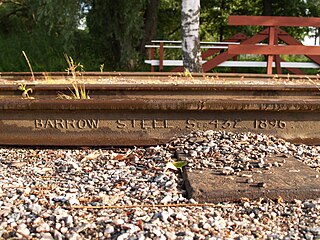
The rail profile is the cross sectional shape of a railway rail, perpendicular to its length.

The Yorktown class was a class of three steel-hulled, twin-screw gunboats built for the United States Navy beginning in 1887. All three ships of the class were named after cities near American Revolutionary War battles.

Shipbuilding in the American colonies was the development of the shipbuilding industry in North America, from British colonization to American independence.
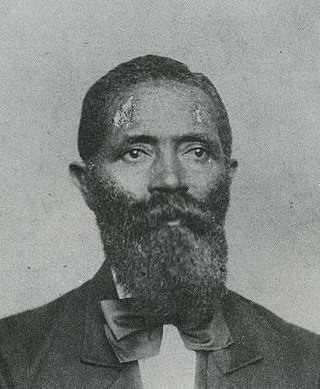
George Teamoh was born enslaved in Norfolk, Virginia, worked at the Fort Monroe, the Norfolk Naval Yard and other military installations before the American Civil War, escaped to freedom in New York and moved to Massachusetts circa 1853, and returned to Virginia after the war to become a community leader, member of the Virginia Constitutional Convention of 1868 and then Virginia Senate during the Reconstruction era, and finally an author in his final years. Teamoh's autobiography is remarkable for his clear rebuke of the military's use of slave labor and the federal government's role both in perpetuating slavery and failing to protect newly emancipated blacks.
I have worked in every Department in the Navy Yard and Dry-Dock, as a laborer, and this during very long years of unrequited toil, and the same might be said of the vast numbers, reaching to thousands of slaves who have been worked, lashed and bruised by the United States government ...

